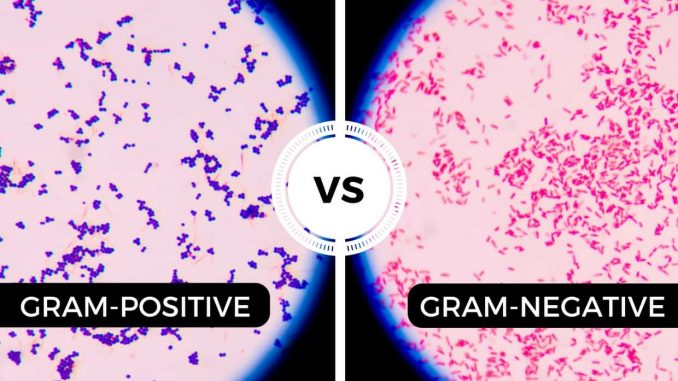
Difference between Gram positive and Gram negative bacteria
SN. |
Point of distinction in characteristics |
Gram Positive bacteria |
Gram Negative bacteria |
| 1. | Gram staining reaction | Retain color of primary satin(crystal violet dye) and appears purple or blue | Gain color of counter stain (safranin) and appears pink or red |
| 2. | Cell wall composition | Peptidoglycan,lipid and teichoic acid | Peptidoglycan and outer membrane (lipid, protein and LPS) |
| 3. | Cell wall thickness | 20-30nm | 8-12nm |
| 4. | Layer of cell wall | Single layer (entirely peptidoglycan layer) | Double layered ( peptidoglycan and outer membrane) |
| 5. | Peptidoglycan layer | thick | thin |
| 6. | Teichoic acid in cell wall | Present | Absent |
| 7. | Outer membrane | Absent | Present |
| 8. | Periplasmic space (space between inner cytoplasmic membrane and outer membrane) | Absent | Present |
| 9. | LPS (lipopolysaccharide) | Absent | Present in outer membrane |
| 10. | Braun’s lipoprotein or murein lipoprotein | Absent | Present |
| 11. | Porins protein | Absent | Present |
| 12. | Peptidoglycan cross linkage between amino acids | Occurs by peptide interbridge (type and numbers of amino acids in interbridge varies among bacteria) | Diaminopamelic acid of one glycan backbone form peptide bond with terminal D-alanine of adjacent glycan backbone |
| 13. | Mesosome | More prominent | Less prominent |
| 14. | Flagella structure | 2 rings in basal body | 4 rings in basal body |
| 15. | L ring structure of flagella | Absent | Present |
| 16. | RNA: DNA ration | 8:1 | Almost 1:1 |
| 17. | Toxin produced | Exotoxin | Endotoxin (primarily) and exotoxin |
| 18. | Resistance to physical disruption | High | Low |
| 19. | Lysozyme digestion of cell wall peptidoglycan | After lysozyme digestion gram positive bacteria become protoplast | After lysozyme digestion gram negative bacteria become spheroplast |
| 20. | Susceptibility to penicillin and sulphonamide | High | Low |
| 21. | Susceptibility to chloramphenicol, tetracycline and streptomycin | Low | High |
| 22. | Resistance to drying | High | Low |
| 23. | Isoelectric pH range | 2.5-4 | 4.5-5.5 |
| 24. | Nutritional requirement | Relatively complex | Relatively simple |
| 25. | Morphology | Usually cocci and rod shaped spore forming bacteria (exception Corynebacterium and Lactobacillus are non-spore forming rod) | Usually rod shape (non-spore forming except Neisseria) |
| 26. | Examples | Staphylococcus
Streptococcus Bacillus Clostridium Nocardia Propionibacterium Enterococcus Corynebacterium Listeria Lactobacillus Gardnerella
|
· Escherichia
· Salmonella · Klebsiella · Proteus · Helicobacter · Hemophilus · Vibrio · Shigella · Neisseria · Enterobacter · Pseudomonas
|
Difference between Gram positive and Gram negative bacteria
